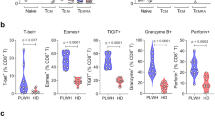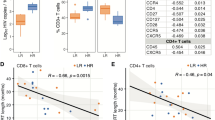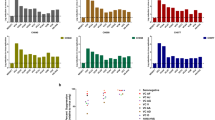Abstract
Changes in CD4+ T-cell surface marker phenotype and antigen receptor (TCR) repertoire were examined during the course of HIV infection and following therapy. A preferential decline in naive CD4+ T cells was noted as disease progressed. Following protease inhibitor therapy, naive CD4+ T cells increased only if they were present before initiation of therapy. Disruptions of the CD4+ TCR repertoire were most prevalent in patients with the lowest CD4+ T-cell counts. Antiviral or IL-12 therapy-induced increases in CD4+ T-cell counts led to only minor changes in previously disrupted repertoires. Thus, CD4+ T-cell death mediated by HIV-1 infection may result in a preferential decline in the number of naive CD4+ T cells and disruptions of the CD4+T-cell repertoire that are not immediately corrected by antiviral or immune-based therapies.
This is a preview of subscription content, access via your institution
Access options
Subscribe to this journal
Receive 12 print issues and online access
$209.00 per year
only $17.42 per issue
Buy this article
- Purchase on Springer Link
- Instant access to full article PDF
Prices may be subject to local taxes which are calculated during checkout
Similar content being viewed by others
References
Lane, H.C. et al. Qualitative analysis of immune function in patients with the acquired immunodeficiency syndrome. N. Engl. J. Med. 313, 79–84 (1985).
Miedema, F. et al. Immunological abnormalities in human immunodeficiency virus (HIV)-infected asymptomatic homosexual men: HIV affects the immune system before CD4+ T cell depletion occurs. J. Clin. Invest. 82, 1908–1914 (1988).
Clerici, M. et al. Detection of three distinct patterns of T helper cell dysfunction in asymptomatic, human immunodeficiency virus-seropositive patients. J. Clin. Invest. 84, 1892–1899 (1989).
Lucey, D.R. et al. Human immunodeficiency virus infection in the US Air Force: Seroconversions, clinical staging and assessment of T helper cell functional assay to predict change in CD4+ T cell counts. J Infect. Dis. 164, 631–637 (1991).
Gray, D. Immunological memory. Annu. Rev. Immunol. 11, 49–77 (1993).
Zinkernagel, R.M. The role of antigen in maintaining T cell memory. Dev Biol, Stand. 82, 189–191 (1994).
Sanders, M.E. et al. Human memory T lymphocytes express increased levels of three cell adhesion molecules (LFA-3, CD2, and LFA-1) and three other molecules (UCHL1, CDw29, and Pgp-1) and have enhanced IFN-gamma production. J. Immunol. 140, 1401–1407 (1988).
Salmon, M., Kitas, C.D. & Bacon, P.A. Production of lymphokine mRNA by CD45R+ and CD45R- helper T cells from human peripheral blood and by human CD4+ T cell clones. J. Immunol. 143, 907–912 (1989).
Sprent, J. & Tough, D.F. Lymphocyte life-span and memory. Science 265, 1395–1400 (1994).
Tough, D.F. & Sprent, J. Turnover of naive- and memory-phenotype T cells. J. Exp. Med. 179, 1127–1135 (1994).
Beverley, P.C. Functional analysis of human T cell subsets defined by CD45 isoform expression. Semin. Immunol. 4, 35–41 (1992).
Mclean, A.R. & Michie, C.A. In vivo estimates of division and death rates of human T lymphocytes. Proc. Natl. Acad. Sci. USA 92, 3707–3711 (1995).
Trowbridge, I.S. & Thomas, M.L. CD45: An emerging role as a protein tyrosine phosphatase required for lymphocyte activation and development. Annu. Rev. Immunol. 12, 85–116 (1994).
Sprent, J. Lifespans of naive, memory and effector lymphocytes. Curr. Opin. Immunol. 5, 433–438 (1993).
Mackall, C.L. et al. Age, thymopoiesis, and CD4+ T-lymphocyte regeneration after intensive chemotherapy. N. Engl. J. Med. 332 143–149 (1995).
Steis, R.C. et al. Kinetics of recovery of CD4+ T cells in peripheral blood of deoxycoformycin-treated patients. J Natl. Cancer Inst. 83 1678–1679 (1991).
Puisieux, I. et al. Oligoclonality of tumor-infiltrating lymphocytes from human melanomas. J. Immunol. 153, 2807–2818 (1994).
Gulwani-Akolkar, B. et al. T cell receptor V-segment frequencies in peripheral blood T cells correlate with human leukocyte antigen type. J. Exp. Med. 174, 1139–1146 (1991).
Cibotti, R. et al. Public and private Vβ T cell receptor repertoires against hen egg white lysozyme (HEL) in nontransgenic versus HEL transgenic mice. J. Exp. Med. 180, 861–872 (1994).
Cochet, M. et al. Molecular detection and in vivo analysis of the specific T cell response to a protein antigen. Eur. J. Immunol. 22, 2639–2647 (1992).
Kovacs, J.A. et al. Controlled trial of interleukin-2 infusions in patients infected with the human immunodeficiency virus. N. Engl. J. Med. 335, 1350–1356 (1996).
Chou, C.C. et al. Phenotypically defined memory CD4+ cells are not selectively decreased in chronic HIV disease. J. Acquir. Immune Defic. Syndr. 7, 665–675 (1994).
Roederer, M. et al. CD8 naive T cell counts decrease progressively in HIV-infected adults. J. Clin. Invest. 95, 2061–2066 (1995).
Rabin, R.L. et al. Altered representation of naive and memory CD8 T cell subsets in HIV-infected children. J. Clin. Invest. 95, 2054–2060 (1995).
Schnittman, S.M. et al. Preferential infection of CD4+ memory T cells by human immunodeficiency virus type 1: Evidence for a role in the selective T-cell functional defects observed in infected individuals. Proc. Natl. Acad. Sci. USA 87, 6058–6062 (1990).
Stanley, S.K. et al. Human immunodeficiency virus infection of the human thymus and disruption of the thymic microenvironment in the SCID-hu mouse. J. Exp. Med. 178, 1151–1163 (1993).
Imberti, L., Sottini, A., Bettinardi, A., Puoti, M., & Primi, D., Selective depletion in HIV infection of T cells that bear specific T cell receptor Vβ sequences. Science 254, 860–862 (1991).
Laurence, J., Hodtsev, A.S. & Posnett, D.N. Superantigen implicated in dependence of HIV-1 replication in T cells on TCR Vβ expression. Nature 358, 255–259 (1992).
Rebai, N. et al. Analysis of the T cell receptor β-chain variable-region (TCRBV) repertoire in monozygotic twins discordant for human immunodeficiency virus: Evidence for perturbations of specific Vβ segments in CD4+ T cells of the virus-positive twins. Proc. Natl. Acad. Sci. USA 91, 1529–1533 (1994).
Westby, M., Manca, F. & Dalgleish, A.G. The role of host immune responses in determining the outcome of HIV infection. Immunol. Today 17, 120–126 (1996).
Dalgleish, A.G. et al. T cell receptor variable gene products and early HIV-1 infection. Lancet 339, 824–828 (1992).
Dobrescu, D. et al. Human immunodeficiency virus 1 reservoir in CD4+ T cells is restricted to certain Vb subsets. Proc. Natl. Acad. Sci. USA 92, 5563–5567 (1995).
Dobrescu, D., Ursea, B., Pope, M., Asch, A.S. & Posnett, D.N. Enhanced HIV-1 replication in Vβ12 T cells due to human cytomegalovirus in monocytes: Evidence for a putative herpesvirus superantigen. Cell 82, 753–763 (1995).
Soudeyns, H. et al. The T cell receptor Vβ repertoire in HIV-1 infection and disease. Semin. Immunol. 5, 175–185 (1993).
Condra, J.H. et al. In vivo emergence of HIV-1 variants resistant to multiple protease inhibitors. Nature 374, 569–571 (1995).
Centers for Disease Control and Prevention, 1994 revised guidelines for the performance of CD4+ T-cell determinations in persons with human immunodeficiency virus (HIV) infections. MMWR Morbid. Mortal. Wkly. Rep. 43, 1–21 (1994).
Genevee, C. et al. An experimentally validated panel of subfamily-specific oligonucleotide primers (Vαl-w29/Vβ1-w24) for the study of human T cell receptor variable V gene segment usage by polymerase chain reaction. Eur. J. Immunol. 22, 1261–1269 (1992).
Arden, B., Clark, S.P., Kabelitz, D. & Mak, T.W. T-cell receptor variable gene segment families. Immunogenetics 42, 455–500 (1995).
Choi, Y. et al. Interaction of Staphylococcus aureus toxin “superantigens” with human T ceils. Proc. Natl. Acad. Sci. USA 86, 8941–8945 (1989).
Arden, B., Clark, S.P., Kabelitz, D. & Mak, T.W. Human T-cell receptor variable gene segment families. Immunogenetics 42, 455–500 (1995).
Pannetier, C. et al. The sizes of the CDR3 hypervariable regions of the murine T cell receptor β chains vary as a function of the recombined germ-line segments. Proc. Natl. Acad. Sci. USA 90, 4319–4323 (1993).
Author information
Authors and Affiliations
Rights and permissions
About this article
Cite this article
Connors, M., Kovacs, J., Krevat, S. et al. HIV infection induces changes in CD4+ T-cell phenotype and depletions within the CD4+ T-cell repertoire that are not immediately restored by antiviral or immune-based therapies. Nat Med 3, 533–540 (1997). https://doi.org/10.1038/nm0597-533
Received:
Accepted:
Issue Date:
DOI: https://doi.org/10.1038/nm0597-533
This article is cited by
-
mRNA vaccine boosters and impaired immune system response in immune compromised individuals: a narrative review
Clinical and Experimental Medicine (2024)
-
Prognostic factors of fungal infection in anti-melanoma differentiation-associated gene 5 antibody-positive associated interstitial lung disease
Clinical Rheumatology (2024)
-
Factors associated with immunosenescence during early adulthood in HIV-infected patients after durable efficient combination antiretroviral therapy
Scientific Reports (2020)
-
Molecular detection, histopathological analysis, and immunohistochemical characterization of equine infectious anemia virus in naturally infected equids
Archives of Virology (2020)
-
Lymphocyte homeostasis is maintained in perinatally HIV-infected patients after three decades of life
Immunity & Ageing (2019)



